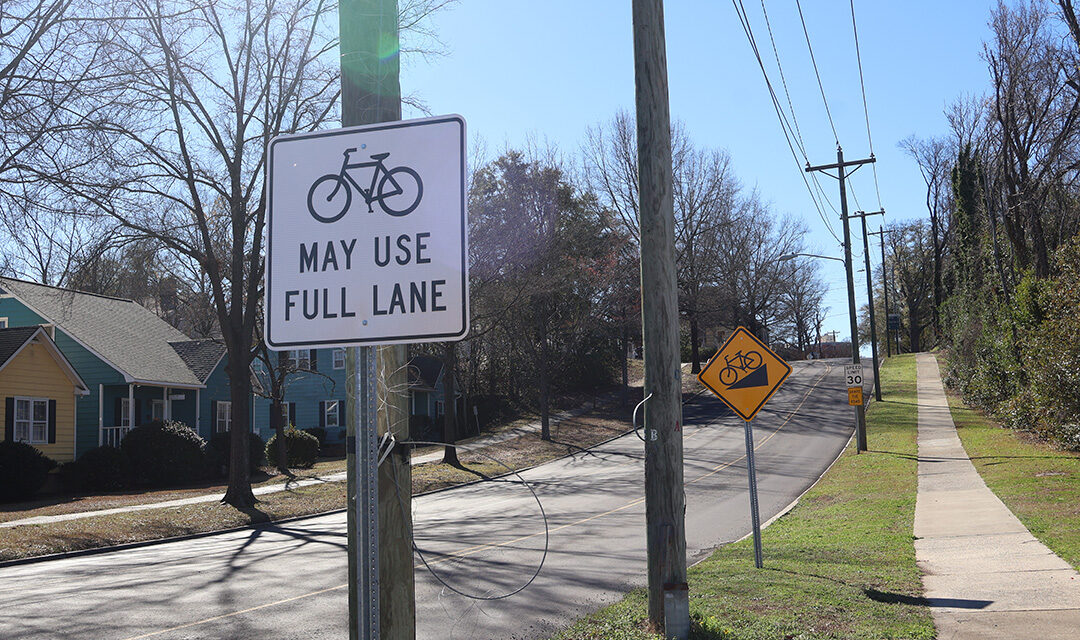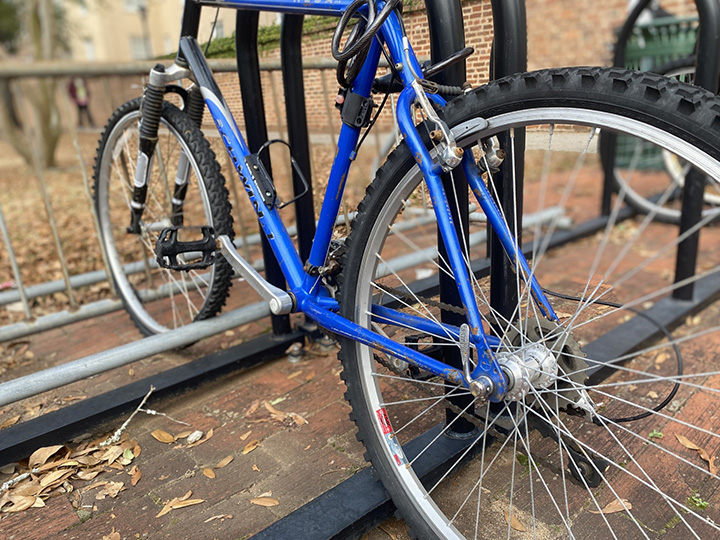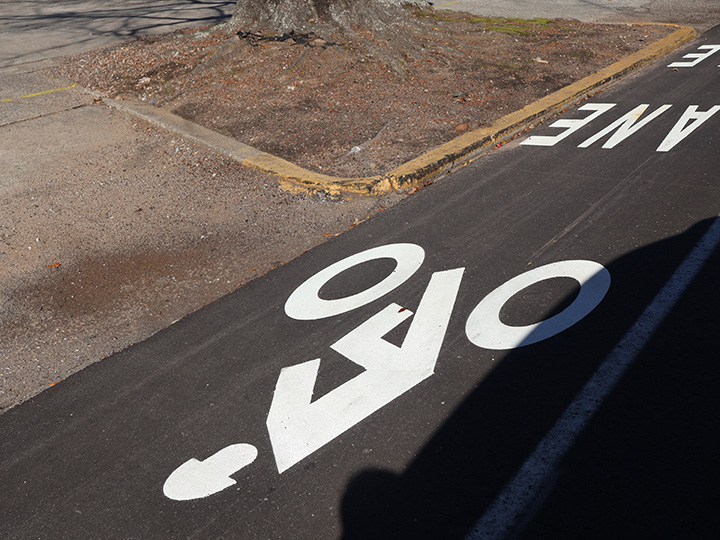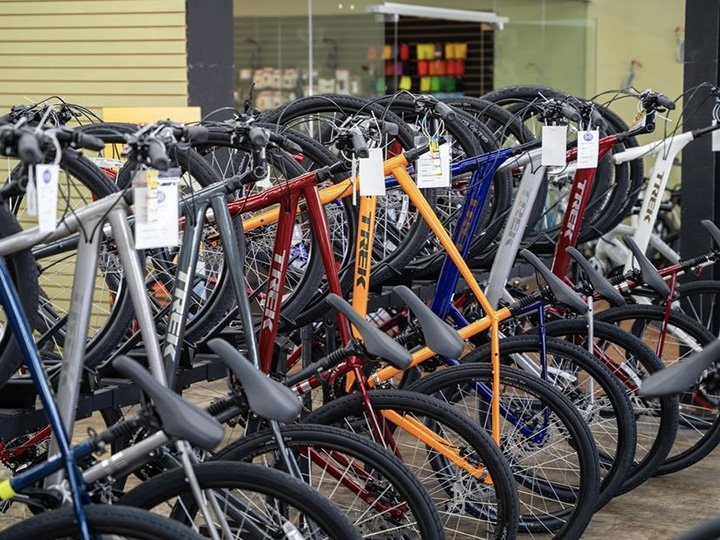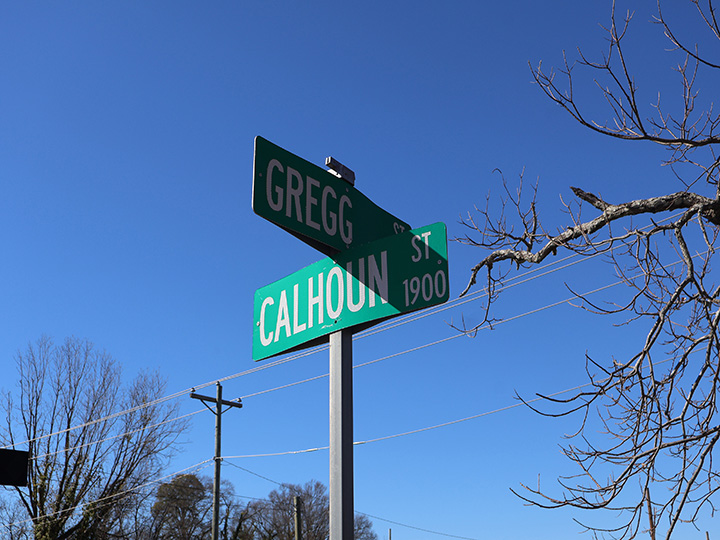Signs for cyclists line Calhoun Street. (Photo by Lauren Larsen/Carolina News and Reporter)
The city of Columbia is slowly adding bike lanes downtown, but cyclists aren’t satisfied with the city’s choices.
The idea is to expand bike accessibility wherever possible.
Most recently, Calhoun Street got new bike lanes because it is a major east and west connector, connecting Wayne and Harden streets, Lucinda Statler, city planning administrator, said.
But local cyclists disagree.
“It doesn’t have any connectivity, so unfortunately, you have to go through some pretty perilous areas to get there,” said Scott Nuelken, executive director of Cola Town Bike Collective. “Nobody’s going to go out of their way to try to make it to that section.”
Nuelken also said the new bike lanes on Calhoun are not safe because parking spaces line the lane, putting cyclists at risk of hitting a car door of someone parking.
Brian Curran, owner of Outspokin’ Bicycles, said he plans on using the new bike lane and has seen the city has made great strides in accessibility since he moved here in 1984.
But like Nuelken, he thinks more recent bike lanes only went in because of needed street renovations.
The city and the South Carolina Department of Transportation work together on projects when roads are state-maintained roads.
If the DOT plans to repave a street where the city has recommended bike facilities, the two projects can be worked on simultaneously, Statler said.
For the past few years, the city’s planning office has facilitated bike-pedestrian counts twice a year, providing a good idea of which locations might benefit from more biking accessibility.
Statler said the way the city is laid out makes certain streets more appropriate for multimodal facilities, including buses and bicycles.
“The great thing about Columbia, especially downtown, is that we have a street grid that provides multiple options for anywhere that you want to go,” Statler said.
Despite his concerns, Nuelken is pleased to see more bike accessibility.
“I’m glad to see that they finally did do something on Calhoun,” Nuelken said. “I mean, it’s three years behind schedule, but I’m glad they finally did something.”
Although the project was to be completed in 2018, by the time the funding and bidding went through, the pandemic interrupted the city’s progress.
“All these supply chain issues, and then labor shortages became a challenge,” Statler said.
Construction of the project began in December 2023. The project was funded by the Richland County penny-on-the-dollar sales tax to improve bike and pedestrian facilities on streets.
The project has been taking a while to complete due to the wetter-than-normal winter, Statler said.
Four years ago, Nuelken, who used to be a member of the city’s Bike and Pedestrian Advisory Committee, said Richland County didn’t want to resurface a road that wasn’t out of date yet.
The city was given a choice to grind and restripe Calhoun Street, but the city chose to wait until the road was due to be resurfaced.
Grinding and restriping grinds up the old lane markings and simply spraying down new lane markings. Resurfacing is grinding up the entire road then putting down a new surface and painting new lines.
“Most cities that are really serious about doing bike infrastructure opt to do the grind and restripe because you can do 10 times the lane miles for the same budget as resurfacing,” Nuelken said.
The Calhoun Street project cost more than $1 million dollars, Statler said.
She said the city hopes to get more money from the federal government and submitted an action plan to make that happen.
Statler said many people are interested in cycling more but nervous about safety concerns.
Having bike-safety infrastructure is “what some people need to determine whether they’re going to ride their bicycle somewhere,” Statler said.
Statler said implementing bike lanes always will cause some motorists to be upset because they don’t want to give up a lane of traffic or fear there will be less space for cars.
“I think that sometimes people don’t understand that bicycles have the same right to be there,” Curran said. “They are a vehicle, and they have the same rights to the road that they do.”
Curran and Nuelken both have concerns about the state’s distracted drivers – due to unfamiliarity with the area, texters or people under the influence – whether or not they are biking on designated bike lanes.
“In Columbia, being a university town, you’ve got newer drivers,” Nuelken said. “So you’ve got a lot of freshmen and sophomore students who may have only been driving for two years and are in an unfamiliar town.”
Students should play an important part in city officials’ decisions, Nuelken said.
“I’m hopeful that we get a City Council that realizes that we’re going to have the younger demographic here that is going to want to be able to commute by bike,” he said. “We need a City Council that sees bikes as a viable alternative to cars.”
A bike locked at a bike rack on Greene Street (Photo by Lauren Larsen/Carolina News and Reporter)
A newly painted bike lane on Calhoun Street (Photo by Lauren Larsen/Carolina News and Reporter)
Bikes lined up for sale at Outspokin’ Bicycles (Photo courtesy of Outspokin’ Bicycles/Carolina News and Reporter)
The intersection of Calhoun and Gregg streets (Photo by Lauren Larsen/Carolina News and Reporter)

